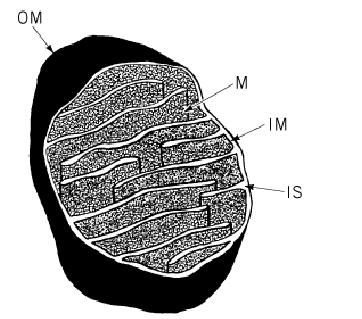


 النبات
النبات
 الحيوان
الحيوان
 الأحياء المجهرية
الأحياء المجهرية
 علم الأمراض
علم الأمراض
 التقانة الإحيائية
التقانة الإحيائية
 التقنية الحيوية المكروبية
التقنية الحيوية المكروبية
 التقنية الحياتية النانوية
التقنية الحياتية النانوية
 علم الأجنة
علم الأجنة
 الأحياء الجزيئي
الأحياء الجزيئي
 علم وظائف الأعضاء
علم وظائف الأعضاء
 الغدد
الغدد
 المضادات الحيوية
المضادات الحيوية|
Read More
Date: 31-12-2015
Date: 22-3-2021
Date: 1-5-2016
|
Cristae
Electron microscopy of mitochondria demonstrates that the inner mitochondrial membrane (IM( folds towards the inner part of the mitochondrion and then folds back (Figure 1), thereby forming structures that are called cristae. The same morphological evidence has shown that a relationship exists between the development of cristae and the functional activity of mitochondria, which is, in turn, related to the energy requirement of the cell. In fact, folding of the inner mitochondrial membrane is a prerequisite for the structural organization of respiratory enzyme complexes. The IM defines the intermembrane space (IS) and the mitochondrial matrix (M), where most soluble enzymes and the protein biosynthesis apparatus are localized, while the respiratory enzyme complexes are localized in the IM. Recently, detailed analysis of mitochondrial inner and outer membranes (OM), of their contacts, and of the localization of proteins in the two membranes, in the intermembrane space, and in the matrix, has led to very important developments in our understanding of the essential aspects of mitochondrial transport. Since the IM and OM separate two distinct spaces in mitochondria, proteins encoded by the cell nucleus and targeted to the mitochondria can be destined to either one of these spaces, or to be integral components of the IM or OM.

Figure 1. Morphology of a mitochondrion derived from electron microscopy (OM = outer membrane; IM = inner membrane; IS = intermembrane space, M = matrix).
Sorting of proteins to mitochondria is generally mediated by presequences, which are by signals composed of 15–35 amino acid residues at the amino terminus. Most proteins to be targeted to the mitochondrion are therefore synthesized on cytoplasmic ribosomes as precursors and then transferred to receptor proteins on the mitochondrial surface. The pre-sequences are then inserted across both membranes at contact points, through distinct outer and inner protein-conducting channels. Many components of this complex machinery for importing proteins have recently been identified (1.(
Transport requires unfolding and refolding of proteins by chaperonins and is followed by removal of the presequence by a proteinase in the mitochondrial matrix. Signal peptides are needed not only for routing proteins to mitochondria but also to reach the correct mitochondrial location. Proteins may actually remain in the matrix, assemble with other proteins in the IM, or be transported to the IS through the IM. An inner membrane–associated proteinase is then used to cleave a second signal peptide from these proteins. However, this very interesting scheme is not general, since some proteins lacking a signal peptide can also be imported into mitochondria.
References
1. T. Lithgow, B. S. Glick, and G. Schatz (1995) Trends Biochem. Sci. 20, 98–101.



|
|
|
|
لخفض ضغط الدم.. دراسة تحدد "تمارين مهمة"
|
|
|
|
|
|
|
طال انتظارها.. ميزة جديدة من "واتساب" تعزز الخصوصية
|
|
|
|
|
|
|
عوائل الشهداء: العتبة العباسية المقدسة سبّاقة في استذكار شهداء العراق عبر فعالياتها وأنشطتها المختلفة
|
|
|